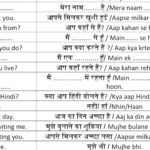The Diversity of Indian Languages: A Cultural Mosaic
India is renowned for its linguistic diversity, which is a testament to its rich cultural heritage and history. The country’s multitude of languages represents a cultural mosaic that reflects the diversity of its people, traditions, and regional identities. This article delves into the fascinating world of Indian languages, exploring their origins, significance, and the cultural richness they bring to the nation.
1. Historical Overview of Indian Languages
**1. **Ancient Roots and Evolution
Overview: Indian languages have deep historical roots, evolving over millennia and reflecting the country’s rich cultural and historical tapestry.
Key Points:
- Indus Valley Civilization: The earliest known scripts, such as the undeciphered Indus script, date back to the ancient Indus Valley Civilization.
- Vedic Sanskrit: The foundation of many Indian languages, Vedic Sanskrit, emerged around 1500 BCE, forming the basis for classical Sanskrit literature and Hindu scriptures.
Examples:
- Rigveda: One of the oldest texts in Vedic Sanskrit, showcasing early linguistic development.
- Classical Sanskrit: Language of ancient Indian epics like the Mahabharata and Ramayana.
**2. **Development of Regional Languages
Overview: Over time, regional languages evolved, influenced by migrations, invasions, and cultural exchanges.

Key Points:
- Dravidian Languages: Originating in South India, including Tamil, Telugu, Kannada, and Malayalam.
- Indo-Aryan Languages: Dominant in North India, including Hindi, Bengali, Marathi, Gujarati, and Punjabi.
Examples:
- Tamil: One of the oldest surviving classical languages, with a rich literary tradition.
- Hindi: Evolved from Sanskrit and Prakrit languages, becoming the most widely spoken language in India.
2. The Linguistic Landscape of Modern India
**1. **The Official Languages
Overview: India recognizes 22 official languages under the Eighth Schedule of the Indian Constitution, reflecting its linguistic diversity.
Key Points:
- Hindi and English: Serve as the official languages of the central government.
- Regional Languages: Each state and union territory has its own official language(s).
Examples:
- Bengali: Official language of West Bengal and significant in Bangladesh.
- Marathi: Official language of Maharashtra, with a rich literary heritage.
**2. **Language Families and Dialects
Overview: Indian languages belong to several language families, each with numerous dialects, further enhancing linguistic diversity.
Key Points:
- Indo-Aryan: Largest language family, including Hindi, Bengali, Punjabi, and others.
- Dravidian: Prominent in South India, including Tamil, Telugu, Kannada, and Malayalam.
- Austroasiatic and Tibeto-Burman: Languages spoken by various indigenous communities.
Examples:
- Bhojpuri: A dialect of Hindi spoken in Bihar and Uttar Pradesh.
- Konkani: A language in the Indo-Aryan family spoken in Goa.
3. Cultural Significance and Influence of Indian Languages
**1. **Literary and Artistic Contributions
Overview: Indian languages have made significant contributions to literature, arts, and culture, enriching the country’s heritage.
Key Points:
- Classical Literature: Ancient texts and epics written in Sanskrit, Tamil, and other classical languages.
- Modern Literature: Contemporary works in regional languages, exploring diverse themes and narratives.
Examples:
- Rabindranath Tagore: Nobel laureate whose works in Bengali have had a profound impact on Indian literature.
- Tulsidas: Author of the Ramcharitmanas, an epic poem in Awadhi, a dialect of Hindi.
**2. **Cultural Identity and Unity
Overview: Indian languages play a crucial role in shaping regional and national identities, fostering a sense of belonging and unity.
Key Points:
- Cultural Festivals: Celebrations and festivals highlighting regional languages and traditions.
- Linguistic Pride: Movements advocating for the preservation and promotion of regional languages.
Examples:
- Pongal: A Tamil harvest festival celebrating Tamil culture and language.
- Bhasha Divas: Celebrations of language days, such as International Mother Language Day, promoting linguistic diversity.
4. Challenges and Preservation Efforts
**1. **Language Endangerment
Overview: Despite the richness of India’s linguistic heritage, many languages are at risk of extinction due to various socio-economic factors.
Key Points:
- Urbanization: Migration to urban areas leading to the decline of regional languages and dialects.
- Education Policies: Emphasis on dominant languages like Hindi and English in education systems.
Examples:
- Kodava: A Dravidian language spoken by the Kodava community in Karnataka, facing decline.
- Sanskrit: Despite its historical significance, it is spoken by only a small number of people today.
**2. **Preservation and Revival Efforts
Overview: Various efforts are being made to preserve and revive endangered languages, ensuring their continued existence and relevance.
Key Points:
- Government Initiatives: Programs and policies aimed at promoting regional languages and literature.
- Community Efforts: Grassroots movements and cultural organizations working to preserve linguistic heritage.
Examples:
- Sahitya Akademi: India’s National Academy of Letters, promoting literature in all Indian languages.
- Language Documentation: Projects recording and documenting endangered languages for future generations.
Conclusion
The diversity of Indian languages is a true reflection of the country’s cultural mosaic. From ancient Sanskrit to modern Hindi, from the Dravidian tongues of the south to the Indo-Aryan languages of the north, each language adds a unique thread to the rich tapestry of Indian culture. As we celebrate this linguistic wealth, it is crucial to recognize and support efforts to preserve and promote all languages, ensuring that this invaluable heritage continues to thrive for future generations.



